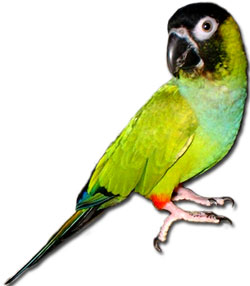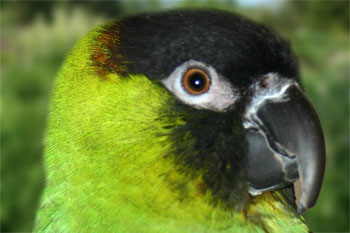|
Nanday
Conure
Scientific Name:
Nandayus nenday
Origin:
South America
(Argentina,
Bolivia, and Paraguay)
Relative Size: Small - 140-160 grams
Average Lifespan: 20-30 years
The Nanday
Conure is a popular conure that is kept in captivity, though not
as popular as Green-cheeked or Sun Conures, they still are highly
sought.
Origin &
Feral Nandays:
These birds are native to Argentina, Bolivia, and Paraguay. They
thrive in cultivated areas and many have been seen in feral flocks
located inside the United States. It is not uncommon to see them
intermixed with Quaker Parakeets or Indian Ringnecks while they
are in feral groups. Most feral Nanday Conures are fed by bird
enthusiasts or they find fruits from neighborhood trees. When in
flocks, their numbers are usually more than 10 birds. While
flying or roosting they emit loud contact calls. Their noisy
calls are what usually divulges their presence. Their green
coloring can make it difficult to be seen in trees or large
shrubs.
Appearance:
This bird is small compared to larger parrots; however, they are
medium sized for conures. They have long slender bodies and a
rounded head. This gives them the impression of being sleek and
stocky. A black mask covers their face and extends below their
beak, often covering the throat. Their bodies are green and a blue
bib masks their crops. The beak is black and is proportional to
their head. The brightest part of the bird is its thighs. They
have orange-red patches that are vibrant. Their tail is also
brightly colored too. It is green and the tips are blue.
Pet Aspect:
Nanday Conures make wonderful pets. They are very curious and
will entertain their owners with their antics. Most Nanday
Conures are very outgoing and will go to strangers if they were
properly socialized and tamed.
They enjoy
being petted and will gladly accept an invitation to be stroked.
This is done by lowering their head and ruffling up their
feathers. They can spend lots of time on their owner’s shoulders,
but don’t expect them to keep still. They usually climb about
their owner’s shirt investigating their surroundings. When calm
or tired, your conure will enjoy snuggling against your neck
(caution should be used to avoid facial bites).
Tricks:
When it comes to tricks, Nanday Conures can easily perform them.
These conures seem to be the preference of trainers when it comes
to bird shows. They are large enough for the audience to view, yet
colorful enough to keep everyone interested.
The tricks
these parrots can perform are endless. In shows, most are used
for retrieving dollar bills from audience members then returning
them. More simple tricks such as waving, turning around, or
dancing can easily be picked up too. Be sure to use positive
reinforcement if you want desired behaviors to stick. You’ll be
amazed at how quickly they mold to positive reinforcement.
 Talking:
Though conures are not known for their talking ability, Nanaday
Conures can learn to talk. Some are able to talk, but those that
do talk, will have raspy voices. Their owners need to spend time
interacting and repeating phrases with them until the conure
starts talking. Trying different tones with your voice will
excite the conure and hopefully encourage talking. If the conure
does not pick up your words, try moving on to a new word. Keep
things exciting and short. A handfed conure is more likely pick
up speech than an untamed one. Talking:
Though conures are not known for their talking ability, Nanaday
Conures can learn to talk. Some are able to talk, but those that
do talk, will have raspy voices. Their owners need to spend time
interacting and repeating phrases with them until the conure
starts talking. Trying different tones with your voice will
excite the conure and hopefully encourage talking. If the conure
does not pick up your words, try moving on to a new word. Keep
things exciting and short. A handfed conure is more likely pick
up speech than an untamed one.
Diet:
The diet of your conure needs to be varied. It should not be fed
only seeds or only pellets. It needs to have a combination of
both. The combination of seeds and pellets are good sources of
nutrition, but fruits and vegetables need to be included too.
These conures particularly enjoy fruits such as grapes or cubed
apples. Adding a daily dose of vegetables is important. Cutting
broccoli into chunks or slicing tomatoes make tasty snacks. Be
sure to include leafy greens such as spinach, kale, romaine
lettuce, or dandelion leaves. They are very nutritious and
important.
|
|
Because
Nanday Conures are omnivores, they need to be give sources of
protein as well. Adding small pieces of turkey or cooked egg is
ideal. Just be sure to remove protein items an hour after being
placed into the cage.
The key is
variety. If you manage to provide a healthy diet you can easily
expect your conure to reach 20 or more years.
|
|


